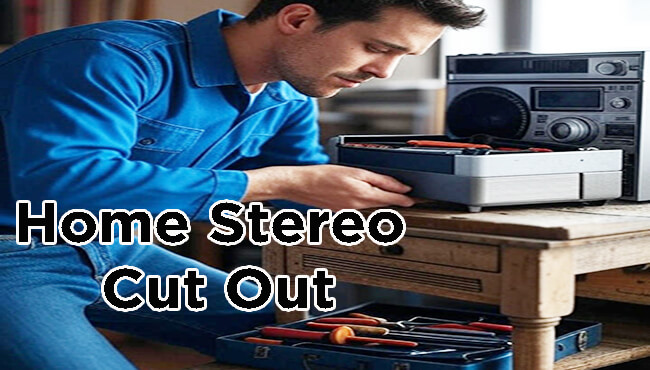Why Does My Home Stereo Cut Out [7 Proven Fixes]
Your favorite song plays, then suddenly stops. This cut-out frustrates every home audio lover. As a technician, I fix these daily. Users share stories of disrupted playlists. Movies lose impact without sound. I empathize with your annoyance completely. This article guides you to solutions. Let’s restore your uninterrupted listening experience.
# Table of Contents =>
- 1 Why Does My Home Stereo Cut Out: 7 Proven Fixes to Restore Sound Fast
- 1.1 The Annoying Cut-Outs:
- 1.2 Starting with the Simplest Checks First:
- 1.3 Checking Speaker Wires and Connections –
- 1.4 Investigating the Overheating Issue –
- 1.5 The Problem of Speaker Impedance –
- 1.6 Are You Pushing It Too Hard?
- 1.7 Faulty Components in the Chain –
- 1.8 The Internal Protection Circuit:
- 1.9 When to Call a Professional Technician –
- 1.10 7 Step by Step Troubleshooting Guide –
- 1.11 Conclusion: Enjoy Uninterrupted Music –
Why Does My Home Stereo Cut Out: 7 Proven Fixes to Restore Sound Fast

The Annoying Cut-Outs:
Stereos cut out to protect themselves. It’s not a random glitch occurring. Protection circuits detect issues like overheating. Loose wires trigger safety shutdowns. Power surges cause abrupt silences. Impedance mismatches strain internal components. These mechanisms prevent permanent damage. Knowing this helps target fixes accurately.
Starting with the Simplest Checks First:
Don’t assume complex issues immediately. Start with easy checks to save time. Loose connections cause most cut-outs. Overheating follows as a close second. Simple inspections often resolve problems. Avoid dismantling without clear evidence. Follow a logical troubleshooting path. This approach ensures efficient solutions.
Checking Speaker Wires and Connections –
User Story: A Common reason:
Imagine a single, tiny wire slipping. A user hosts a lively party. Music stops mid-dance, ruining vibes. She finds a loose speaker plug. Many report similar connection woes. Vibrations loosen cables over time. This interrupts signal flow frequently. Simple checks restore audio clarity.
Why It Causes Cut-Outs –
Loose wires create intermittent signal breaks. Stereos detect these as faults. Protection circuits halt operation instantly. Dust in jacks worsens connectivity. Banana plugs slip from ports. RCA cables degrade with movement. This triggers sudden audio dropouts. Secure connections prevent these issues.
How to Fix It –
- Unplug the Stereo: Disconnect from power. This ensures safety during inspections.
- Inspect Cables: Check speaker wires visually. Look for frayed or loose ends.
- Tighten Connections: Twist banana plugs firmly. Push RCA jacks in securely.
- Clean Jacks: Use compressed air. Remove dust from ports gently.
- Test Stability: Tug cables lightly. Ensure they stay in place.
- Replace Damaged Wires: Swap out worn cables. Use high-quality replacements.
- Secure Setup: Tie cables neatly. Prevent vibrations from loosening them.
- Test Audio: Power on and play. Verify sound stays consistent.
Investigating the Overheating Issue –
User Experience: Heat Ruins the Mood
Picture a summer movie night. The stereo cuts out repeatedly. A user finds it’s too hot. Cabinets trap heat, causing shutdowns. Many describe similar warm-weather issues. Fans block vents with clutter. Overheating disrupts their listening joy. Ventilation solves this common problem.
Why Overheating Causes Cut-Outs –
Amplifiers generate heat during use. Excessive warmth triggers thermal protection. Circuits shut down to avoid damage. Enclosed spaces block airflow paths. Dust clogs cooling fans inside. High room temperatures worsen conditions. This leads to frequent cut-outs. Proper cooling prevents these interruptions.
How to Fix It –
- Power Off: Unplug the stereo. Let it cool for safety.
- Check Placement: Move from enclosed cabinets. Ensure open space around vents.
- Clean Vents: Vacuum dust from openings. Use compressed air for fans.
- Monitor Temperature: Feel the unit’s surface. Avoid hot environments.
- Add Cooling: Install small external fans. Improve airflow around the device.
- Use Surge Protectors: Stabilize power supply. Prevent heat from surges.
- Test Operation: Play music for 30 minutes. Check for cut-outs.
- Schedule Maintenance: Clean internals yearly. Prevent dust buildup issues.
The Problem of Speaker Impedance –
User Tale: A Setup Misstep –
A collector upgrades his vintage speakers. The stereo cuts out instantly. He overlooks impedance ratings initially. Another wires multiple speakers incorrectly. Sound drops at high volumes. Mismatched gear frustrates many users. Forums buzz with similar stories. Impedance issues cause frequent shutdowns.
Why Impedance Causes Cut-Outs –
Speakers and amps need matching impedance. Low impedance overworks amplifiers heavily. Protection circuits engage to safeguard. This prevents component burnout risks. Parallel wiring lowers resistance further. Mismatched setups trigger safety modes. Cut-outs protect your stereo system. Correct ratings ensure stable performance.
How to Fix It –
- Unplug Device: Disconnect power completely. Avoid electrical hazards during checks.
- Check Ratings: Read speaker impedance specs. Compare with amplifier manual.
- Measure Impedance: Use a multimeter. Verify speaker resistance matches.
- Rewire Correctly: Use series wiring. Increase impedance if needed.
- Add Resistors: Insert if impedance is low. Consult technician for guidance.
- Test Gradually: Play at low volume. Monitor for cut-outs.
- Replace Mismatched Gear: Buy compatible speakers. Match amp specifications.
- Consult Manuals: Follow manufacturer guidelines. Ensure proper setup configurations.
Are You Pushing It Too Hard?
User Story: Volume Overload Woes
A DJ cranks music for a gig. The stereo cuts out mid-set. High volumes trigger protection modes. Another user blasts workout tracks. Sound vanishes at peak moments. Party hosts face similar issues. Overloading amps causes abrupt silences. Moderation keeps systems running smoothly.
Why Overloading Causes Cut-Outs –
High volumes strain amplifiers significantly. Protection circuits detect clipping risks. They shut down to save speakers. Distortion signals impending overload issues. Excessive bass demands extra power. This activates safety cut-off modes. Over driving leads to sudden dropouts. Controlled levels prevent these problems.
How to Fix It –
- Turn Off Stereo: Unplug for safety. Reset the system completely.
- Lower Volume: Start at 20% capacity. Increase slowly while listening.
- Check for Distortion: Listen for buzzing. Reduce volume if heard.
- Set Limits: Use built-in limiters. Check settings in the menu.
- Balance EQ: Reduce heavy bass settings. Distribute sound evenly.
- Upgrade Amps: Consider more powerful models. Handle high volumes better.
- Monitor Apps: Use volume control apps. Track safe listening levels.
- Educate Users: Teach household safe ranges. Prevent reckless volume spikes.
Faulty Components in the Chain –
User Experience: Tracking Down Faults
A gamer enjoys immersive audio daily. The stereo cuts out unexpectedly. He swaps inputs and finds issues. Another tests different speakers. One fails to produce sound. Families report source device glitches. Faulty components disrupt their setups. Isolation testing identifies the culprit.
Why Faulty Components Cause Cut-Outs –
Defective parts disrupt signal chains. Faulty cables send erratic signals. Bad sources trigger protection circuits. Aging capacitors fail under stress. Damaged speakers cause short circuits. These issues prompt safety shutdowns. Identifying faulty components restores audio. Systematic testing isolates the problem.
How to Fix It –
- Unplug Everything: Disconnect power sources. Ensure safety during tests.
- Test Sources: Try different input devices. Swap CD players or phones.
- Swap Cables: Replace RCA or HDMI cables. Use known working ones.
- Check Speakers: Test each speaker individually. Identify faulty units.
- Inspect Internals: Look for burnt smells. Avoid touching live circuits.
- Use Multimeter: Test component continuity. Verify cables and connections.
- Replace Faulty Parts: Swap defective items. Purchase reliable replacements.
- Retest System: Reconnect and play audio. Confirm consistent sound output.
The Internal Protection Circuit:
Protection circuits monitor system health. Faulty circuits misinterpret normal signals. They trigger cut-outs unnecessarily often. Aging components cause erratic behavior. This isn’t a user-fixable issue. Opening stereos risks electrical shocks. Professional tools diagnose circuit faults. Expert repair ensures safe solutions.
When to Call a Professional Technician –
DIY fixes sometimes fall short. Persistent cut-outs signal deeper issues. Your efforts deserve recognition regardless. Professionals use specialized diagnostic tools. They safely handle internal repairs. Warranty services cover many fixes. Local shops restore systems efficiently. Expert help saves time and stress.
Benefits of Professional Service:
A user visits a repair shop. Technicians fix a faulty capacitor. Music plays perfectly afterward. Another uses warranty services. Free repairs solve cut-out issues. Forums recommend trusted technicians. Positive outcomes rebuild confidence. Families enjoy uninterrupted audio. Professional expertise ensures lasting fixes.
7 Step by Step Troubleshooting Guide –
- Check Connections First: Inspect all speaker wires. Tighten loose plugs securely. Clean jacks with air. Test audio after adjustments. Secure cables to prevent slips. This resolves common cut-outs quickly.
- Assess Power Supply: Measure outlet voltage levels. Replace faulty extension cords. Install surge protectors now. Monitor for voltage dips. Ensure stable electricity flow. Unstable power causes frequent interruptions.
- Investigate Overheating Issues: Relocate stereo to open areas. Clean vents and fans. Add cooling aids if needed. Monitor unit temperature closely. Avoid enclosed spaces always. Proper ventilation prevents thermal shutdowns.
- Verify Impedance Matching: Check speaker and amp ratings. Measure with a multimeter. Rewire in series configuration. Add resistors for corrections. Test at low volumes. Mismatches trigger protective modes often.
- Eliminate External Interference: Move away from routers. Shield cables with ferrite beads. Ground the system properly. Test in isolated rooms. Avoid appliance overlaps. Clear signals ensure stable audio.
- Adjust Volume Levels: Start playback at low settings. Increase gradually without distortion. Set internal limiters on. Balance EQ for even sound. Monitor with volume apps. Overload activates safety cut-outs.
- Perform Maintenance and Tests: Vacuum dust from internals. Clean contacts thoroughly. Update firmware if available. Test components individually. Document all findings clearly. Seek professionals for persistent issues.
Conclusion: Enjoy Uninterrupted Music –
Your troubleshooting journey restores audio joy. Start with simple checks like connections. Address overheating and impedance issues. Control volume and test components. Seek professionals for complex faults. These steps fix cut-out problems. As a technician, I ensure reliability. Enjoy your stereo without interruptions.
Last Updated on October 5, 2025 by Perry Garner


